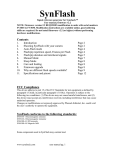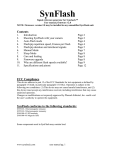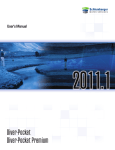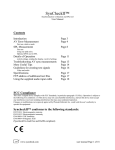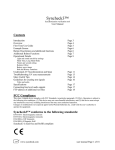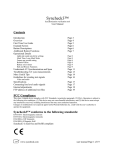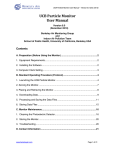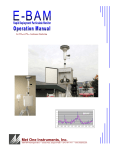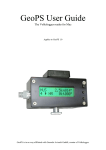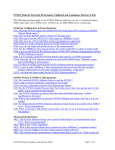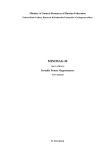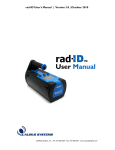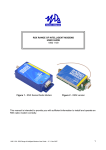Download SynFlash user manual 1.05
Transcript
SynFlash Signal reference generator for Syncheck™ User manual Contents 1. 2. 3. 4. 5. 6. 7. 8. 9. 10. Introduction Shooting SynFlash with your camera Auto-Flash mode How SynFlash works with interlaced signals Manual Mode Sleep Mode Why are different flash rates available? Care and feeding Firmware upgrade Specifications and pinouts Page 2 Page 2 Page 4 Page 5 Page 6 Page 7 Page 8 Page 10 Page 11 Page 12 FCC Compliance This device adheres to part 15 of the FCC Standards for test equipment as defined by paragraph 15.3(dd), in particular paragraph 15.103(c). Operation is subject to the following two conditions: (1) This device may not cause harmful interference, and (2) this device must accept any interference received, including interference that may cause undesired operation. Changes or modifications not expressly approved by Pharoah Editorial, Inc. could void the user’s authority to operate the equipment. SynFlash conforms to the following standards: EN55103-1 Electromagnetic emission EN55103-2 Electromagnetic immunity EN61000-4-3 RF Immunity EN61000-4-8 Magnetic field Some components within SynFlash contain lead. At this time SynFlash does NOT meet lead-free initiatives. www.syncheck.com user manual pg. 1 Introduction Inserting SynFlash into its protective rubber boot. Install a 9 volt battery first. The rubber boot is friction fit and is “pulled on” over SynFlash. It includes a convenient swing-out foot on its back. For now, make certain the foot is pressed flat against the boot. Place the empty boot flat on a surface, open side up. Insert SynFlash’s battery end into the boot’s bottom, seating it into the boot. As you lower SynFlash into the boot, grab the boot’s thin upper lip and guide it across and above the white LEDs. We use both hands. Take care not to push the LEDs into SynFlash with excess force! SynFlash is a companion product to Syncheck™ designed for use in front of your video camera as part of a complete shoot-to-finish synchronization check of audio and video signals. Synflash with Syncheck™ will allow a fast and accurate study of audio-to-video synchronization errors at many points along the way from initial shoot to release. SynFlash generates precise visual and aural markers that are recorded by your equipment and checked with Syncheck™ immediately or later, perhaps at a distant location, for synchronization. SynFlash is designed for quick setup and ease of use. SynFlash REQUIRES a video reference signal for precise operation. When locked to your video reference, the green lock LED will be lit. There are two distinct modes of operation, Auto-flash and Manual modes. If SynFlash cannot lock to your reference signal at power up for some reason, it will power up in Manual mode only. Shooting SynFlash with your camera We suggest that if you are using a tube-type camera you should iris down when SynFlash is aimed directly at your camera! SynFlash’s white LEDs are rather bright (although nowhere near the intensity of regular stage lighting). While we do not expect phosphor burn due to SynFlash’s LEDs we suggest that you err on the side of caution. The best advice we can give about shooting SynFlash’s white LEDs with your camera is to shoot them as tightly and fully-framed as possible. It will make no difference whatsoever if the LEDs are in focus or not, in fact a wildly out of focus shot may actually work best. It is ideal to achieve full frame flashes against a black or very dark background, with black or near-black video in between flashes. The closer you are to achieving a perfect white flash against a black background, the easier it will be to use Syncheck™ later. Because Syncheck™ depends on contrast changes from dark to light to detect marker frames, bright objects or reflections in your image may require masking to eliminate them from Syncheck’s view. Sometimes a simple adjustment of the playback monitor’s brightness or contrast controls will allow perfect results, but a bit of practice shooting and measuring BEFORE you are in the field will be wise! As we said, attention to how you shoot SynFlash will be rewarded later. Try to eliminate everything except SynFlash’s LEDs from your video frame. The easiest way is to bring SynFlash and your lens face to face, using SynFlash’s case to block everything else. It is often helpful to iris down and/or insert a neutral density filter to darken your image. SynFlash will work with the camera’s automatic gain on or off as long as you take care that the LED flashes primarily dominate the image. Because automatic gain tends to clip www.syncheck.com user manual pg. 2 the brightness of the flashes and raise gain in between, it is better to turn off automatic gail. In daylight and depending on lens opening size, it may also be helpful to fashion a rough hood from a piece of cardboard or stiff paper with a hole large enough for SynFlash to protrude through. The cardboard can be brought into contact with the lens hood, blocking ALL light except that from SynFlash. Such a hood is simple, cheap, and highly effective. You may wish to paint your handiwork black as well, but such extremes are often not necessary. You must record audio pips from SynFlash at the same time you shoot its flashes. Turn off automatic sound gain if possible! Hold your microphone close to SynFlash’s audio transducer. A distance of a couple of inches will work in all but the noisiest of environments. In noisy environments you will benefit by getting the microphone as close as possible. Because SynFlash pips are very short, automatic gain will almost always reduce the pips level while raising the ambient level. That is opposite to what you will want! www.syncheck.com user manual pg. 3 Auto-flash mode It is highly recommended to apply a video reference signal to one of SynFlash’s BNC connectors before turning it on. SynFlash’s two connectors form a simple loop-through with negligible load. Because SynFlash does not terminate the BNCs you may loop the reference signal to another device or terminate it with a 75-ohm terminator. The reference signal needs to be reasonably stable. SynFlash will probably not be able to lock to your consumer VHS deck, for example, because it lacks a timebase corrector. Most professional sources are acceptable. With your reference already connected, turn on SynFlash. It should power up into Autoflash mode. If you hold the mode switch down during power up SynFlash will enter Manual mode, which we will discuss later. For now, simply turn it on. SynFlash should lock onto your reference and determine the signal’s frame rate. (If your reference is not detected for some reason, SynFlash will power up in Manual mode.) Syncheck is “aware” of three frame rates, 24, 25, and 30. 23.976 is treated as 24 and 29.97 is treated as 30, and so on. (A software update will allow double-rate signals to function properly.) If SynFlash is locked to your reference signal the green LED will light. If the reference signal is temporarily interrupted for some reason it is possible for SynFlash’s hardware to become confused. If this happens you may need to turn SynFlash off (for two to three seconds) and on again. If at any time Syncheck suddenly acts erratically, a power cycle will quickly restore expected operation. Once locked, the white LEDs will flash with a simultaneous audible “pip”. We call these “flash/pips”, oddly enough! The flash/pips occur at regular intervals and 2 out of every 16 flash/pips are inhibited, leaving a space. The purpose of this space will be discussed at the end of this section. The speed of repetition of our flash/pips is initially determined by your reference signal’s frame rate. In the following discussion we will use two terms that may cause some confusion because the terms may appear similar, in print. “Frames per second” refers to the rate of video images; “frames per flash” defines the speed of flashes from SynFlash. Video signals are divided into frames with a specific number of frames per second, abbreviated as fps. Video, for example, is typically delivered to our eyes at 24, 25, or 30 fps (frames per second). Our white LEDs will flash repetitively, one flash each time 8, 10, or12 frames of video have passed. We define the speed of flashing as 8, 10, or 12 frames per flash (fpf). A speed of 10 fpf means that the white LEDs will light during only one of 10 frames in a row. You should understand the difference between flames per second (fps) and frames per flash (fpf) before proceeding or you may become very confused! When detecting a new frame rate (power on) SynFlash will pick one of two default flash/pip repetition speeds, either 8 or 10 frames per flash. 24 fps video selects a speed of 8 fpf by default while 10 fpf is selected for the other two frame rates. (We will discuss later why these two flash speeds were chosen.) If SynFlash cannot determine a video frame rate (rate is NOT 24, 25 or 30) but is still able to lock to the reference, the flash/pip speed will default to one flash per second. You may always change the flash/pip speed by momentarily pressing the rate switch. Each press will cycle to the next frames per flash setting. As long as SynFlash is locked to a video reference you are free to select any of www.syncheck.com user manual pg. 4 the five possible settings: 8 frames per flash (fpf), 10fpf, 12fpf, 1 per second, and none. You may also press and hold the mode switch to enter Manual mode. We will discuss Manual mode later. (Once you have entered Manual mode you must power cycle SynFlash to return to Auto-flash mode.) During auto-flash mode the flashes and acoustic pips are precisely locked to your video reference, turning on and off at specific video line numbers. Generally speaking the LEDs are lit only during the “active video” portion of each frame and extinguished during intervening timing and vertical blanking intervals (see text box at right). The flash/pip duration is just slightly less than a full video frame.*note 1 For a flash/pip rate of 8 fpf for instance, the LEDs will be lit during the first of 8 frames and extinguished during the next seven. When interlaced video signals are used you may use the Field switch to select whether a flash/pip begins at the start of video field 1 (F1 dominant) or video field 2 (F2 dominant). *note 2 The field switch has no effect when progressive video standards are used. For many uses proper Syncheck measurements can be made no matter how the switch is set. If you do not know which setting is best, we suggest leaving it set at F1 for PAL and F2 for NTSC. Example: How SynFlash works with an interlaced NTSC reference containing 525.5 lines of video. Rather than thinking of NTSC video as 29.97 frames per second, we prefer to think of it as 59.94 fields per second. If a flash rate of 10 is selected (the power-up default), there will be one flash/pip for every 20 fields (10 frames) of video. Assuming the field switch is set to “F1”, the white LEDs and audible pip will turn on at the beginning of line 21, near the start of field 1, and remain continuous through the end of line 525, the end of field 2. The LEDs will remain lit during the entire portion of active video of both fields, as well as during the vertical interval separating field 1 and field 2. If the field switch is set to “F2” the LEDs will light at the beginning of line 283, near the start of field 2, and extinguish half way through line 263 of the following frame. The exact line numbers when SynFlash turns on and off are probably unimportant to you as long as it is understood that a camera WILL NOT see any light from SynFlash except during the intended two video fields. Audible pips are turned on and off exactly with the white LEDs. SynFlash’s transducer contains a piezoelectric crystal speaker. It has a relatively quick startup time and in practice the time between LED turn on and first detectible sound With interlaced PAL signals the LEDs will is less than .3ms, a short enough delay to be turn on starting with line 23 (field switch set ignored for our purposes. We highly to F1) or 336 (field switch set to F2), and recommend that you place your recording extinguish half way through line 623 (switch microphone close to SynFlash’s transducer to set to F1) or the end of line 310 (switch set to reduce the effects of acoustic properties of the F2). As with NTSC, the exact line numbers space you are recording in, as well as eliminate are relatively unimportant as long as it is any additional time delay caused by sound understood that a camera WILL NOT see propagation through the air. Because sound any light from SynFlash during any portion travels through air at roughly 1 millisecond per of frames other than the intended one. foot the distance between SynFlash and your microphone can make a small but noticeable and measurable sync error. By placing your microphone within a few inches of SynFlash, both potential problems are greatly reduced. You may use SynFlash’s line level output * note1: Some progressive tri-level sync types will cause flash/pips of exactly 2 frames duration rather than 1 frame, however other operation remains identical. Two frame flash/pips will not interfere with Syncheck readings. * note2: Some non-standard composite video formats, such as those produced by certain consumer VCR machines, do not allow SynFlash to detect the difference between field 1 and field 2, and thus the field switch will have no effect. www.syncheck.com user manual pg. 5 instead of a microphone pickup. This signal, a replica of the transducer’s output, is available on pin 5 of the DIN8 connector. In practice, a microphone is probably easier and more relevant. In cases where the system under test causes a large difference between audio and video delivery times (out of sync), up to several seconds, SynFlash supports two additional methods to help restore proper audio/video offsets. The original Syncheck™, our earlier companion product, can show up to only 4 video frames offset, a quarter second. The more recent SyncheckII™ (and Syncheck™ with the “broadcaster’s” modification) can show up to 16 video frames offset, a half second. Some additional help is needed when the sync error is more that that. As you have probably noticed, our flash/pip pattern is very regular but some of the flash/pips are missing. SynFlash uses a pattern of 14 regularly spaced flash/pips followed by two “skipped” flash/pips. The space resulting from these skips provides a human reference point for manual estimation. For instance, 30fps video using a flash/pip speed of 10fpf results in skipped flash/pips every 5.3 seconds. By watching and listening, a rough correction may be manually estimated and applied. After the large error has been corrected to within the limits of your Syncheck™, (4 or 16 frames depending on model) final adjustments can be made using Syncheck™ in the traditional way. Some people may find it easier to look for the presence of a single flash/pip instead of looking for a space in an ever-repeating pattern. You may place SynFlash into a manually triggered mode of operation, much like an electronic clapper stick, to trigger single flash/pips at will. Manual Mode For manual “clapper stick” type of operation, the mode select switch or an externally connected button switch (via the DIN8 jack) can be pushed to cause one or more flash/pips. If a reference signal is connected the flash/pips will be synchronized properly to your reference. There are three ways you may enter Manual mode.To enter Manual mode from Autoflash mode, press and hold the mode select switch. After a couple of seconds SynFlash will enter Manual Mode. The red “M” LED will light but all others will extinguish. (If SynFlash is still locked to your reference the green lock LED will remain lit.) You may enter Manual mode directly at power on by holding the mode switch down before turning on SynFlash. SynFlash will enter Manual mode silently and without a flash. The third way to enter Manual mode is to turn on SynFlash without a reference signal connected. You must power cycle (turn off, wait two to three seconds, turn on) to return to Autoflash mode. Once in Manual mode, SynFlash waits until you press the mode select switch. When pressed, Synflash will flash/pip as it does in Auto-flash mode. As long as you hold the switch, flash/pips will repeat. The speed of repetition is usually the same as was last used in auto-flash mode (8, 10, 12, or 1 per second). If the recalled rate is invalid, a 1 per second rate is calculated. As long as a valid reference signal is connected the flash/pips are placed precisely with the reference’s active video lines, just as they are during Autoflash mode. The field switch is active with interlaced reference signals, just as in Autoflash mode. If a reference is not connected, the speed of flash/pip repetition is www.syncheck.com user manual pg. 6 predetermined (NOT based on your video reference’s frames per second), and the length of the flash/pips are extended to about 75 milliseconds, a length that guarantees a video camera running at any usual video standard will record at least one completely white frame. When using SynFlash in manual mode it is generally possible to release the switch after only one flash/pip, particularly with slower flash/pip speeds, however we recommend that you allow at least two or three flash/pips. Having more than one will prove to be especially convenient later on when measuring with Syncheck. Also, it is possible that the mechanical switch noise of the mode switch may be recorded by your microphone and later mistaken as the start of a pip, giving a false synchronization error. By using several flash/pips instead of relying on the first, any possible ambiguity is eliminated. An external pushbutton may be connected to SynFlash’s DIN8 jack, between pin 7 and pin 1 (SynFlash ground). When operating in Manual mode, the pushbutton will trigger flash/pips exactly as the mode select switch does. Both are active. The external pushbutton input is ignored at all other times. You can connect directly to the supplied DIN8 cable or build your own. With our cable, connect the pushbutton between the black (ground) and blue wires. We have included one other function of Manual mode we call Flashlight. If you have no reference connected to SynFlash, the field switch becomes an on/off switch for the white LEDs, allowing SynFlash to function as a flashlight! Because the LEDs draw considerable battery power, we force much of the remaining circuitry including the microprocessor into a low-power sleep mode. Unfortunately, we must occasionally wake up the processor in order to read the switches and discover if one of them was changed! The processor’s wakeup cycle causes a very short “wink” of the LEDs approximately every second. Sleep Mode In order to save battery power further, we take advantage of some limited opportunities for SynFlash to enter an extended low-power snooze. Snooze is entered after approximately two minutes of unattended operation (the mode switch was not pressed). Snooze is not allowed during Auto-flash mode except during no-flash operation (it is easy to forget that SynFlash is turned on when it is not flashing!). While snoozing, all outputs and LEDs are turned off and the processor enters a low power state. You can return to normal operation by holding down the mode key briefly (less than 2 seconds usually), or with a power cycle. Snooze is allowed during all manual mode operations. The only indication that SynFlash is snoozing is a very brief flash of the red “M” LED every two seconds. Battery drain is reduced but not eliminated, so you should always power off SynFlash when not needed. www.syncheck.com user manual pg. 7 Why are different flash rates available? If you do not wish to follow the discussion in this section, simply follow the chart printed on SynFlash’s panel to determine the flash rate you should use. Normally, the default rate selected at power on is best, but please read the last two paragraphs in this discussion! Three flash/pips repetition speeds (flashes per frame) have been chosen for SynFlash to help us identify errors during frame rate conversions. If no rate conversion will be required, for instance when shooting, editing, and releasing at 25 fps, any repetition speed will work as well as any other. If you need to shoot at one frame rate and perform some work at another there will be a frame rate conversion involved at one or more points along the work path. Syncheck™ can help spot all errors introduced by the conversion process but we must take care not to introduce errors in our measurements where none actually exist. Take the case of converting from 24 fps (or 23.976) progressive to 30 fps (or 29.97) interlaced, as when shooting 24fps film and editing on a system capable only of 30fps display. A frame rate conversion is required to stretch those 24 frames into 30, usually via a “2:3 pull up” process. Remember as you read that each of the 30 new frames is made up of 2 fields. There are 60 fields per second. When converting the original 24 frames per second, half of them (every other one) are simply copied across into new frames. An original frame becomes a new frame, 1 frame is copied into 1 frame. The remaining half of the original frames is copied into three fields of the new video (1 frame of original becomes 1.5 frame of new). This alternation of one frame into 2 fields with the next frame into 3 fields is called 2:3 pull up. Chart 1 below will help reveal how each second of the original 24 frames is distributed into 60 fields (30 frames) of new video. Chart 1 includes two possible versions of this process, first where the first original frame is copied to two fields and the other where the first original frame is copied to three fields. Both are equally likely. Ignore the blue areas for the moment. 30i frames 30i fields 24p 2:3 1 1A 2 1B 30i fields 24p 2:3 24p 3:2 3 2B 1 3A 4 3B 2 1 24p 3:2 30i frames 2A 9 12A 13A 6A 14A 7A 8 7B 5 14B 15 15A 8B 9A 15B 16 16A 10A 7 17A 8 18 17B 18A 14 13 10B 8 17 16B 13 12 10 9B 7 6 12 11 9 8A 6 5 14 13B 7 6B 4 11 10 6 5B 4 13 12B 10 9 5A 3 12 11B 5 4B 3 2 11 11A 4A 19 18B 19A 15 14 Chart 1, 30-24 conversion with 5 frames per flash Let us look at how SynFlash’s flash/pips fit into this process. If we had chosen a SynFlash speed of 5 fpf, where its white LEDs would flash every fifth frame, the chart’s blue areas show that some flashes would be converted into only two fields while others would be converted into 3 fields. Two noteworthy things would happen to our flashes. First, some of them would be two fields long and some would be three fields long. Inconsistent lengths of our new frames would not matter because Syncheck ignores the length of each flash, but the timing between the start of each frame would be unavoidably altered at the same time. Sometimes there would be 12 fields between flashes, other times there would be 13 fields between flashes. This would cause a half-frame “chatter” in the error reading displayed by Syncheck. While technically accurate, it would be a www.syncheck.com user manual pg. 8 15 9B variability that over time would average to zero. We do not care about the chatter. Instead, we are more interested in whether the overall offset between audio and video has been changed, in other words “is one consistently ahead of the other?” By selecting a flash rate that will be consistently converted into the new rate, we can eliminate the measurement “chatter”. To accomplish this, SynFlash defaults to a speed of 8fpf (frames per flash) for 24fps reference signals. On Chart 2 below the blue areas show where our flashes occur. You can see that 8fpf will convert perfectly into 10 fpf when the 24 frames are converted into 30. Even though some flash frames will be converted into two fields and others into three fields, the time between each flash start will be consistent. Looking at this from the other direction, when detecting a 30fps reference SynFlash defaults to a speed of 10 frames per flash. 10 fpf converts evenly to 8 fpf at 24fps. In fact, it should be possible to convert from 24 to 30 and back to 24 with no “chatter” at either rate. 30i frames 30i fields 24p 2:3 1 1A 2 1B 3 2B 1 3A 4A 12A 9 13A 9 24p 3:2 6B 14A 7B 15A 8B 9A 16A 17A 8 18 17B 13 10B 8 17 16B 12 10A 7 16 15B 10 9B 7 6 12 11 9 8A 6 15 14B 11 10 8 7A 5 14 13B 10 7 6A 4 13 12B 5B 5 3 12 11B 6 5A 4 2 11 11A 5 4B 3 1 30i frames 4 3B 2 24p 3:2 30i fields 24p 2:3 2A 18A 14 13 19 18B 19A 15 14 Chart 2, 30-24 conversion with 8 frames per flash If you were following this discussion you may notice that using a flash speed of 4 (for 24fps) or 5 (for 30fps) would work just as well as our choices of 8 (for 24fps) and 10 (for 30fps). There would be more flashes per second which might be helpful, and Syncheck™ can accept the faster rate, but if the acoustic pips are played in a highly reverberant room with long acoustic decay times there could be trouble distinguishing one pip from the next. To reduce the likelihood of this possibility we have settled on a slower speed of 8fpf. For 25fps operation, Syncheck defaults to 10 frames per flash, which will convert exactly to 12 fpf at 30 frames (Chart 3 below). In cases where only the playback speed is changed, such as shooting at 24 fps but speeding up the playback to 25fps, it does not matter what flash speed is chosen because no frame conversion is taking place, and SynFlash’s default values are perfectly okay. 30i frames 30i fields 25 1 1A 1A 2A 2B 4 3B 4A 3A 3B 8A 6B 6 7A 9A 7B 7 4A 5B 4B 10 9B 10A 8A 8B 8 6 5A 6A 5B 5 11 10B 11A 9A 11B 9B 9 6B 5A 4 9 8B 5 4B 3 8 7B 6A 3A 2 7 7A 3 2B 1 30i frames 25p 2A 1B 25p 30i fields 25 2 1B 12 12A 10A 12B 10B 10 Chart 3, 30-25 conversion aid www.syncheck.com user manual pg. 9 13 13A 14 13B 11A 11B 11 14A 14B 12A 12B 12 15 9B When should you use a flash rate other than the default value? There is a rate conversion that Syncheck’s defaults do not adequately cover. If you wish to shoot at 30fps and convert to 25fps, a flash speed of 12 is best even though SynFlash will default to 10. 12fpf must be selected manually. Another potentially troublesome conversion is between 24 and 25 fps (either direction) with NO playback speed change (1 second = 1 second). We suggest using a default rate in these cases. The typical method of converting from 24 to 25 with no time speedup is to repeat one of the 24 frames each second, while the typical method of converting from 25 to 24 with no time slowdown is to omit one out of every 25 frames. We believe the best method to measure time offsets with either of these circumstances is to use Syncheck’s default rate and “visually estimate” an average offset. When measuring the converted picture with Syncheck you will see the offset value change with each flash/pip. The amount of change from one flash/pip to the next will stay within a range of one full frame. An average offset error somewhere in the middle of the range is probably the best compromise. Why do we not recommend one flash per second? We prefer to avoid the possibility that our single frame flash will either be dropped or doubled, depending on the direction of the conversion. We also believe more flashes per second are a better indicator of what is actually occurring. We have provided a 1 flash per second selection should you desire it. Care and Feeding of SynFlash We provide a rubber protective boot that we recommend unless you need access to the DIN-8 jack. We have designed SynFlash to accept normal wear and tear but we will not warrant your unit against careless abuse. Switch handles can be broken off with excessive force so take normal care when packing the unit for travel. As with any modern electronic device, static discharge of sufficient intensity may overcome the builtin protections. Take care to prevent static discharge into the unit, particularly into external DIN-8 plug connections. In static-prone environments you should always discharge yourself by touching one of the connected BNC jacks, or any metal ground point, first. SynFlash is not waterproof! The audio transducer is not guaranteed against water damage. If you anticipate use in the rain it is possible to cover the acoustic transducer holes with a material such as SaatiTech’s B025Hyphobe (www.saatitech.com). This is a mesh material that will affect acoustic output somewhat but will not allow casual water penetration. An easier way to prevent rain damage is to operate SynFlash within a clear plastic bag. We also suggest that you use the supplied rubber boot to retard weather entry into the DIN-8 jack and battery compartment. Keep a fresh battery handy. SynFlash benefits from full battery voltage with brighter flashes and louder pips. SynFlash will drain your battery if left on or accidentally turned on during storage or travel. Firmware Upgrade Firmware is upgradeable via PC. Mac is not supported for firmware upgrade at this time, but is expected to be in the future. You may download an executable file from our www.syncheck.com user manual pg. 10 website and connect SynFlash using the cable supplied or suitable equivalent. If you do not have a DB9 serial connection you may use a USB to serial converter. Not all work, however. (Belkin F5U109 does NOT work!) We have tested the FTDI US232B adapter, available here: http://www.parallax.com/detail.asp?product_id=800-00030. Many others should work. You may send the unit to us for firmware upgrade, if you wish. We will charge only for shipping. www.syncheck.com user manual pg. 11 Specifications Video reference: black burst, composite sync, and composite video SD Standards: 625PAL and 525NTSC. 625SECAM is untested but should work Tri-level sync: most progressive or segmented scan (see note 2, page 5) Frame rate: between 24 and 60 (720P24/25 not supported without segmented scan) Flash/audio pip rate: 12, 10, 8 frames per flash/pip, 1 per second, manual trigger Acoustic output: 2.9-3.1Khz, 90db at 1 foot Audio output: approx 2V p-p Battery: 9V standard alkaline Weight: 1 lb Pin out of auxiliary 8-pin DIN connector 1 – Ground 2 - +9V (diode isolated from battery) 3 – PC Serial “atn” 4 – PC Serial “data out” 5 – Audio line out unbalanced, 120 ohm 6 – PC Serial “data in” 7 – Slate button (connect other side of button to pin 1 ground) 8 – LED “ON” logic out, high when white LEDs are on. ◘8 ◘7 ◘6 ◘5 ◘4 ◘3 ◘2 ◘1 To wire your own serial cable: Head start hint: a popular computer uses serial cables with DIN8 connectors. Snip off one end and you are halfway done. 9 pin Dsub Din8 . 2 serial out 4 Orange 3 serial in 6 Green (or purple) 4 attn 3 Red (or yellow) 5 gnd 1 Black 6 jumper 7 together SynFlash DIN-8 jack www.syncheck.com Typical serial cable Black Brown Red Orange Yellow Green Blue Purple user manual pg. 12












